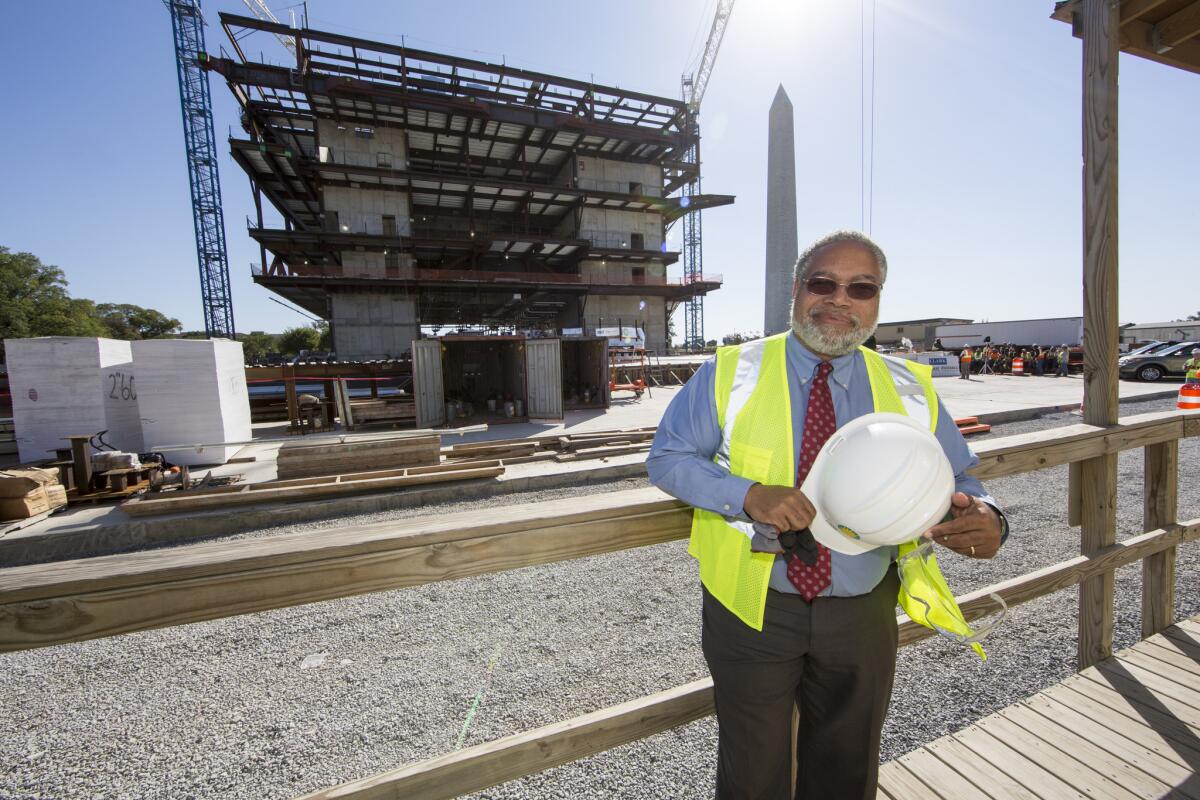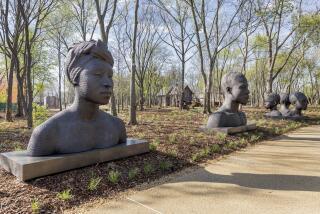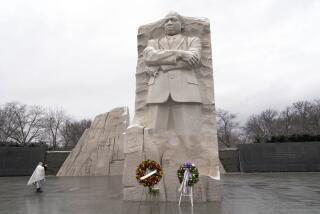Lonnie Bunch reflects on journey to national African American museum

Like Atlas in ancient Greek mythology, Lonnie Bunch has an immense load to carry as founding director of the Smithsonian National Museum of African American History and Culture, which is now under construction near the Washington Monument on the National Mall in Washington, D.C.
As Bunch enters the home-stretch of a decade-long drive to conceive, build and launch the 380,000-square-foot museum, which is expected to open by summer 2016, what he’s shouldered has the potential to turn into a keg of cultural dynamite.
No American issue has been bigger, harder, more wrenching or enduring than race. None is more explosive. But where Atlas strained and groaned, Bunch, 61, exudes enthusiasm and an easygoing, friendly aplomb. Nine years into his job, his risky task only seems to enliven him.
The African American experience, says the smiling, round-faced historian, curator and museum administrator, “is the lens through which we understand what it is to be an American. In some ways, the African American experience is the quintessential American experience.”
Like many facets of the museum he’s shepherding, that statement could itself be debated. But it’s a point Bunch can stand behind. All great national sagas are about struggle and aspiration. More than 400 years after the arrival on the continent of Africans who would become slaves, by some clear measures the experience of African Americans remains just that — a struggle.
How to encompass it in exhibitions is something Bunch began thinking about systematically when he left his first museum job at the Smithsonian National Air and Space Museum to become the first history curator of the California African American Museum, which opened in 1984 in L.A.’s Exposition Park.
Bunch subsequently spent 12 years at the Smithsonian National Museum of American History, where he headed the curatorial department, then acquired experience as a chief executive at the Chicago Historical Society (now known as the Chicago History Museum).
In December 2003, Congress enacted a bill creating the national African American museum, pledging to fund half the cost of construction and installing exhibits — which will come to about $255 million of a $510 million total. The museum also will receive about $40 million a year in government funding for operations after it opens.
Bunch, who began as director in 2005, says about $65 million remains to be raised toward the private share. He’s hired a staff of 150 people; with help from outside scholars, Bunch and his curatorial team have brainstormed over how best to make sense of the African American experience for an expected public of 3 million or more annual visitors, plus tens of millions more online.
Instead of siphoning objects from existing Smithsonian collections, the African American museum set about building its own collection from scratch. A whites-only lunch counter from a crucial 1960 civil rights sit-in in Greensboro, N.C., will remain at the National Museum of American History, where Bunch says it serves an important purpose in an appropriate context. Instead, the African American museum has acquired 35,000 artifacts, photographs and documents of its own, many tracked down in a series of “Antiques Roadshow”-like events around the country that offered free expert advice on how to preserve African American heirlooms.
Oprah Winfrey, Chuck Berry and Bill and Melinda Gates have made significant contributions of money or things, but so have others of more humble means. Bunch says he was especially moved when a woman brought in a Croix de Guerre, a coveted French medal for combat valor, that was awarded to her grandfather in 1919 for serving with the Harlem Hellfighters, a black American regiment that fought with distinction during World War I under French command.
People have given, Bunch said, because “everybody knows how big a deal this is.” He estimates that two-thirds of the collection has been donated.
Collection pieces range in size from a 2-inch amulet shaped like a slave shackle that was worn in West Africa centuries ago as a talisman against being seized by slavers, to the Mothership, a huge space-craft that was the signature stage prop for 1970s arena concerts by funk-rock maestro George Clinton and his band, Parliament-Funkadelic.
“Let’s just say there will be sound and lights,” Bunch said with a chuckle, when asked how the Mothership will be deployed in a museum gallery.
The exhibits won’t flinch from the most tragic episodes in African American history, Bunch assured, but they will aim to show how tragedy has been channeled into a drive for progress and change. His guiding principle is to make the museum about people more than events.
“We want to bring everything to a human scale. Rather than coming and saying you’ve learned about slavery, you’ll say, ‘I’ve learned about people who went through that experience.’”
One of the 11 core exhibits covers events since 1968, and, with collection items that include gang bandannas, it won’t omit the anguishing reality of violence, the physical and social ravages of crack addiction, or the repercussions of drug laws that sent astonishing numbers of inner-city blacks to prison for nonviolent offenses.
Bunch said the museum can and will take on any controversy, including fresh ones such as the killing of Trayvon Martin, the fatal shooting of Michael Brown by police in Ferguson, Mo., or the recently rekindled call for a national discussion of reparations to African Americans for their ancestors’ labor.
“I don’t think there is a story or subject that we won’t touch,” Bunch said. “It’s a question of how you do it. Our job is not to force-feed people but to help them understand the [historic] context and bring real knowledge to the debate.”
Bunch said he knew going in that this wouldn’t be easy. One of the first people he called when he was offered the job was W. Richard West Jr., who’d taken a similar ride over comparable historical terrain as founding director of the Smithsonian National Museum of the American Indian.
“I said, ‘OK, is this a fool’s errand or what?’” Bunch recalled this week during a stopover in L.A. in which he was feted at the Getty Museum and gave a talk for the Town Hall Los Angeles discussion series — all part of the promotional phase that’s begun for the African American museum.
West, who’s now president of the Autry National Center of the American West in Los Angeles, said that like the American Indian museum, the African American one will give the nation both a centralized podium for pride in a group’s achievements and a forum for painful but necessary conversations about injustices past and present.
“These spaces should be safe places for unsafe ideas,” West said, and because sharp criticism is inevitable, running one is not a job for anyone who has a thin skin or a hot temper.
“[Bunch] has a clear conception of what he is trying to accomplish, and he will defend it as he should in the face of criticism from whatever quarter it may come,” West said. “And it will come.”
That’s for later. For now, Bunch can talk about the museum’s support in Congress from across the political spectrum, and how it has managed so far to avoid being turned into “a political football.”
“It’s the story that helps us understand how freedom comes, how citizenship is gained,” he said. “It’s hard for anybody to be against that.”
He can enjoy moments such as the recent morning in L.A. when he visited his former professional home, the California African American Museum, for the first time in nearly a decade. Vida Brown, an art curator, introduced herself as someone he wouldn’t remember, but told him he’d made a big difference in her life in the mid-1980s, when she was fresh out of Pepperdine and working in the insurance business while volunteering on weekends as a guide in the museum galleries.
Before each history show opened, Brown recalled, Bunch would walk the guides through the exhibition, explaining the objects and their themes.
“He was a great storyteller,” Brown said. “He always put his explanations in a format you could remember. I thought, ‘If I move forward in the art arena, I want to be like him in the sense of how he told stories, how he approached people, and how he made them feel.’”
It won’t be too long before Bunch gets the rare opportunity of approaching people by the millions, through the museum he is now shaping. One way or another, he’ll find out how he’s made them feel.
Twitter: @boehmm
More to Read
The biggest entertainment stories
Get our big stories about Hollywood, film, television, music, arts, culture and more right in your inbox as soon as they publish.
You may occasionally receive promotional content from the Los Angeles Times.







